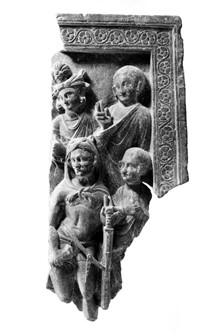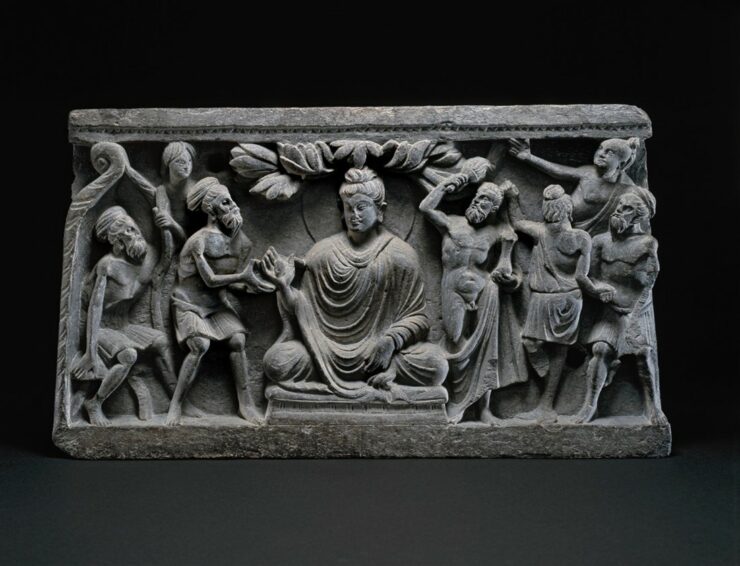Chunrong Zhao
How to evaluate and represent eclectic material culture has become a hot-debated issue in archaeology, art history, and material cultural studies for quite a time. Around eclectic material cultures, quite a few terms have been applied to “material signs of cultural mixture” (Van Pelt 2013, 2) for analytical purposes, e.g., hybridity, creolization, and mestizaje [1]. However, most of these analytical attempts inevitably fall into the quagmire of “pseudo-multiplicity” (Guattari and Deleuze 1987, 8), a plight caused by the mindset of essentialism as a colonial legacy. Guided by my research interests in cultural eclecticism in general and cultural exchanges along the Silk Road in particular, I conducted research on Gandhāran Buddhist material culture during my master’s program. In my thesis, I not only attempt to deconstruct the essentialist way of thinking, but also to develop a constructive translocative method to research postcolonial material cultures. To my delight, my thesis was awarded the NGG Cornelis Tiele MA Thesis Award in 2020. In this blog post, I will briefly introduce the results of my research.
Essentialism as a Colonial Legacy
Essentialism is a reductionist idea that assumes that there is some “essence” to individuals in a particular category. Essentialization tends to exaggerate, sharpen, and over-estimate the differences or the boundaries between the classified categories by projecting some essences as intrinsic parts of these categories. As a result, essentialism distorts reality by setting immutable essences and ignoring the internal diversity within the classified categories. The essentialization of cultures has a deep colonial background. Through cultural essentialization, colonizers deliberately constructed the distinct boundaries between themselves and the colonized, between “the Self” and “the Other,” between “Western” and “non-Western” in order to maintain their self-proclaimed superiority. Gandhāran Buddhist material culture could not escape the fate of being exploited by the British colonial agenda. It became a prime example to demonstrate the desirable achievements of the Greek civilizing influence on the East in history. Although, since the 19th century, a considerable number of anti-colonial or post-colonial interpretations have appeared to attempt to criticize and counteract this Orientalist colonial view, they were ironically caught in the trap of cultural essentialism, implying their continued use of the conventional concept of culture, which considers cultures as externally exclusive and internally unified spheres.
Translocality as a Conceptual Tool
Instead of following the essentialist approach, I turned to the concept of “translocality” to examine Gandhāran Buddhist material culture. Inspired by Thomas Tweed’s theory of crossing and dwelling, I began to pay attention to the dynamic interdependent relationships between the processes of dwelling and crossing in religious/cultural interactions. A culture can be both a specific fluid moment in a dynamic process of cultural interactions (crossing, fluid aspect) and a marker of a particular local identity (dwelling, anchoring aspect). In the term “translocality,” the prefix “trans-” highlights the mobility and connectedness of cultural flows in translocative interactions, whereas the root concept “locality” reveals local people’s need to know who they are, where they live, and what makes them different. Combining the two, the concept “translocality” allows to pay equal attention to both the fluid aspect and the anchoring aspect of cultures. Adopting “translocality” as my conceptual frame, I drew upon the method of translocative analysis proposed by Tweed, who suggests that to study religion is also to trace the flows of people, rituals, artifacts, beliefs, and institutions across spatial and temporal boundaries (Tweed 2006, 23).
The Vajrapāni Case
I take the figural features of Vajrapāni in Gandhāran Buddhist material culture as an illustration to exhibit how a translocative viewpoint can assist with analyzing and representing eclectic material cultures. Some of the most notable characteristics of Gandhāran Vajrapāni—for example, the lion-skin headgear and the robust torso—originated from the image of Heracles in ancient Greece. Heracles’ figural characteristics went through an immense number of localities among Eurasia, such as Attica in Greece (6th century BC), the Hellenistic outposts in Western and Central Asia (4th-1st century BC), Gandhāra (2nd-3rd century AD) and Hadda (4th century AD) in today’s Pakistan and Afghanistan, and farther localities eastward, such as Kizil and Maijishan (6th century AD) in China. Heracles’ figural features traveled through these localities to reach farther areas in the broad network but also dwelled in these localities, being diffused and transformed. Despite the fact that the flow of Heracles’ figural features that once contributed to the iconography of Vajrapāni in Gandhāra originated from the ancient Greek region, we cannot merely credit the image of Gandhāran Vajrapāni to the passive acceptance of ancient Greek influence. On the one hand, the localization of Heracles’ figural features in Gandhāra cannot be separated from the agency of local Buddhist devotees and sculptors. They were not negatively “influenced” by the streams, yet actively domesticated the image, negotiating its appearance in their own spiritual aim. They deliberately retained a portion of Heracles’ figural features (lion-skin headgear and robust torso), but relinquished the other (wooden club) to depict their own Buddhist deity. On the other hand, the cross-Eurasian interactions were never as direct and self-evident as some colonial scholars believed or wanted to believe. Cultural flows are never to be pure and static. They are constantly interacting with the localities that they moved across, being diluted or concentrated, discarded, or retained. Therefore, I describe Gandhāran Buddhist material culture as strikingly translocative.

© The Trustees of the British Museum.

British Museum, London. © The Trustees of the British Museum.
Translocative Framework
Based on the Vajrapāni case study, I theorize a translocative framework that can be applied in the study of both religions and cultures as follows:
- Specific religious or cultural elements move through a series of localities in the form of flows, crossing space and time. In the process of moving and crossing, these flows can be either controlled, manipulated, propelled, compelled, constrained, or blocked by powers, institutions, commercial exchanges, or other social activities.
- Localization: By taking agentive local action, people in a particular locality (A) (in both spatial and phenomenological sense) consciously choose, adopt, absorb, adapt, have recourse to, pick up, engage with, react to, emulate, remodel, reconstitute, develop, or transform the religious/cultural elements brought about by the flows moving through the locality. In this way, these elements are accommodated to a particular locality (A), merging into the local social landscape, contributing to the local process of homemaking as well as the formation of local identity and local expressive schemes.
- Fluidization: After being localized in a particular locality, the elements from the flows have become part of local entanglements, being internalized through local actions, reactions, adaptions, and innovations. The localized (and thus transformed) elements then also merge into the streams that move out of the locality (A) through the channels provided by the larger network, serving as fresh resources for localization and homemaking in other localities (B, or C, D, E, etc.).
- Re-localization: In other localities (B, or C, D, E, etc.) that encounter the flows—which continuously absorb fresh local elements from the localities they have passed through, such as locality (A)—new processes of localization can happen. These re-localization processes in other localities lead to making and remaking, formation and reformation, configuration and reconfiguration of their own local identities and stylized local expressions.
- Re-fluidization: The new local elements from various processes of agentive localization once again move out of the localities (B, or C, D, E, etc.) through the channels provided by the larger network, providing resources for localization and homemaking in farther localities again. These new local elements can move back and forth between different localities embedded in the network. For example, they can flow back to the locality (A) where flows once passed through, promoting the remaking and remodeling of local identities and local expressive schemes in locality (A); they can flow back and forth among other localities as well (from B to C, from C to B, from D to B, etc.).
- This framework reveals a repeatable and sustainable cycle: localization, fluidization, re-localization, re-fluidization, re-re-localization, re-re-fluidization…It is noteworthy that these processes can generate multiple “runways” of flows, but are not limited to a single one. When a stream of flow [2] passes through a locality, it can be divided into several currents, moving out of this particular locality, with the cultural elements of the former flow being scattered or completely retained and taken away by various other currents. The newly merged local elements can move together with scattered or completely retained elements through the multiple “runways” of the flows to move farther and farther.
- A single stream of flow usually happens chronologically; but different streams in the large network can happen either simultaneously or chronologically.
Theoretical Relevance
To summarize, the translocative approach has several advantages to capture eclectic material cultures in a postcolonial manner:
1. It provides us with a more nuanced way to represent eclectic material cultures, such as Gandharan Buddhist material culture, by attending to the diverse local idiosyncrasies at a microscopic level without reducing or neglecting the complexity of cultural interactions, integrations, and innovations.
2. It helps resume local people’s agencies by seeing local people as active agents engaging with dwelling and crossing, rather than as passive recipients of foreign influences.
3. It can help us reflect upon the politicalized discourses in preceding scholarships to provide a relatively unbiased interpretation. On the one hand, it challenges the colonial discourses with their colonialist implications. On the other hand, it can also help us reflect upon the anticolonial discourses with their nationalist assumptions. By attending to cultural idiosyncrasies at a microscopic local level, translocative framework aims to restore agency and subjectivity to the flexible localities in a microscopic sense but not to any essentialist entities.
4. It encourages us to pay attention to the dynamic dialectical relationships between dwelling/locality and crossing/mobility in religious/cultural interactions and entanglements.
5. Last but not least, it can also help open up more space for interdisciplinary cooperation in cultural or religious studies in general. For example, it might assist archaeologists and art historians to reflect upon their stylistic analyses, a lot of which used to be conducted through an essentialist theoretical lens; it might be of help for museum curators to address the question how to represent and display eclectic material cultures; and it might also inspire religious studies scholars to theorize translocative phenomena in some religions, such as Christianity and Islam.
End Notes
[1] Mestizaje means the process of interracial and/or intercultural mixing, especially in Hispanic American contexts. It is derived from the Spanish adjective mestizo, a term historically used in Latin America in the 20th century to describe a person combined with European and indigenous American descent. [2] The description of “a single stream of flow” is only for analytical purposes. To recognize and designate a particular stream of flow depends on the specific concerns of our research, the themes that we focus on, and the materials that we draw upon.References
Guattari, Félix, and Gilles Deleuze. A Thousand Plateaus: Capitalism and Schizophrenia. Minneapolis: University of Minnesota Press, 1987.
Tweed, Thomas. Crossing and Dwelling: A Theory of Religion. Cambridge and London: Harvard University Press, 2006.
Van Pelt, W. Paul. “Introduction.” In Archaeology and Cultural Mixture, edited by W. Paul van Pelt, 1-10. Cambridge: Archaeological Review from Cambridge, 2013.

